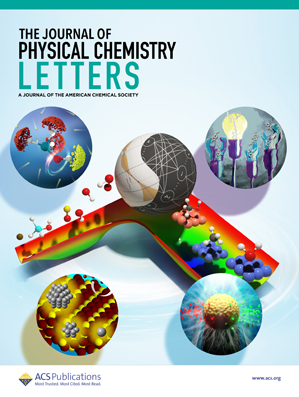Gas-Phase Synthesis of Germanium Monosulfide (GeS, X1Σ+) via the Elementary Reaction of Atomic Germanium (Ge, 3P) with Hydrogen Sulfide (H2S, X1A1)
IF 4.8
2区 化学
Q2 CHEMISTRY, PHYSICAL
引用次数: 0
Abstract
Germanium belongs to the carbon group in the periodic table; however, its chemical behavior sometimes differs from that of carbon, defying the isoelectronic rule proposed by Langmuir. One notable example is germanium monosulfide (GeS, X1Σ+), where germanium exhibits remarkable stability in the +II oxidation state, unlike carbon in its monosulfide form. Germanium monosulfide (GeS, X1Σ+) is a promising material, with applications ranging from optoelectronic devices to highly efficient semiconductors. Here, we report on the gas phase synthesis of germanium monosulfide (GeS) through the elementary reaction between ground-state atomic germanium (Ge, 3P) and hydrogen sulfide (H2S, X1A1) via nonadiabatic reaction dynamics exploiting the single-collision approach in a crossed molecular beams machine. The integration of electronic structure calculations and experimental findings reveals that the reaction dynamics proceed via intersystem crossing (ISC) to produce singlet germanium monosulfide (GeS, X1Σ+) and molecular hydrogen. This result provides an intricate reaction mechanism for the germanium–hydrogen sulfide system via germanium–sulfur bond coupling and demonstrates the “heavy atom effect” facilitated intersystem crossing yielding nearly exclusive singlet germanium monosulfide. This outcome also emphasizes that elementary reactions involving atomic germanium and hydrogen sulfide are quite different from those observed in the carbon–hydrogen sulfide or silicon–hydrogen sulfide systems.原子锗(Ge, 3P)与硫化氢(H2S, X1A1)的元素反应气相合成单硫化锗(GeS, X1Σ+)
锗在元素周期表中属于碳族;然而,它的化学行为有时与碳不同,违背了朗缪尔提出的等电子规则。一个值得注意的例子是单硫化锗(GeS, X1Σ+),其中锗在+II氧化状态下表现出显著的稳定性,不像碳在单硫化形式下。单硫化锗(GeS, X1Σ+)是一种很有前途的材料,应用范围从光电子器件到高效半导体。本文报道了基态原子锗(Ge, 3P)和硫化氢(H2S, X1A1)在交叉分子束机中通过非绝热反应动力学,利用单碰撞方法,气相合成单硫化锗(GeS)。电子结构计算和实验结果的结合表明,反应动力学是通过系统间交叉(ISC)产生单线态单硫化锗(GeS, X1Σ+)和分子氢。这一结果为锗-硫化氢系统通过锗-硫键偶联提供了一个复杂的反应机制,并证明了“重原子效应”促进了系统间的交叉,产生了几乎完全的单线态单硫化锗。这一结果也强调了涉及原子锗和硫化氢的元素反应与在碳-硫化氢或硅-硫化氢体系中观察到的反应有很大的不同。
本文章由计算机程序翻译,如有差异,请以英文原文为准。
求助全文
约1分钟内获得全文
求助全文
来源期刊

The Journal of Physical Chemistry Letters
CHEMISTRY, PHYSICAL-NANOSCIENCE & NANOTECHNOLOGY
CiteScore
9.60
自引率
7.00%
发文量
1519
审稿时长
1.6 months
期刊介绍:
The Journal of Physical Chemistry (JPC) Letters is devoted to reporting new and original experimental and theoretical basic research of interest to physical chemists, biophysical chemists, chemical physicists, physicists, material scientists, and engineers. An important criterion for acceptance is that the paper reports a significant scientific advance and/or physical insight such that rapid publication is essential. Two issues of JPC Letters are published each month.
 求助内容:
求助内容: 应助结果提醒方式:
应助结果提醒方式:


